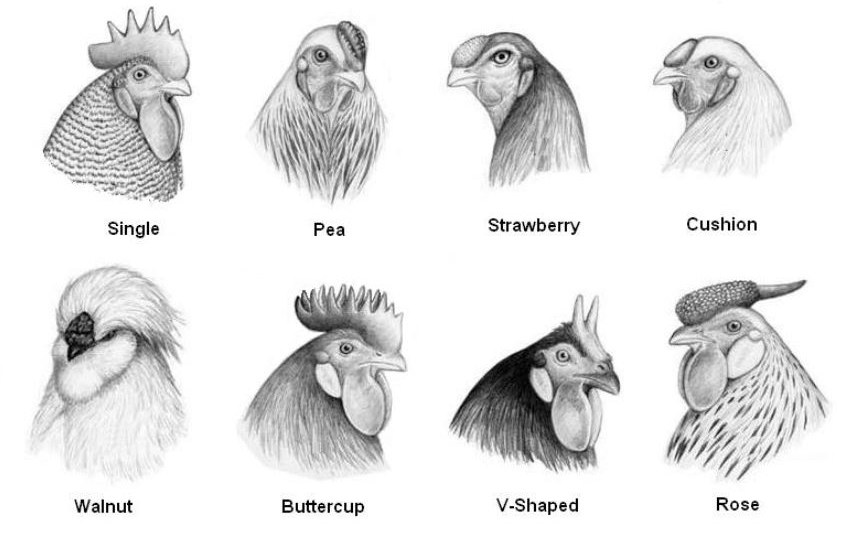As the leaves start to change and the temperatures start to dip at night/in the mornings, you know winter is coming. This morning, I went outside to bring my kids to school and for the first time this season, I could see my breath in the air.
This is the time of year you start to think about your flock and wonder, do chickens need heat in the winter? When should I heat my coop? Should I even add heat to my backyard coop? If so, at what temperature should I heat my coop at?
We have a lot of experience with this particular topic. We first started keeping chickens when we lived in the sub-arctic in Northern Canada; in the Northwest Territories. We continued keeping chickens (and honeybees) when we moved to the Yukon. I'll point those places out on a map for reference (see my red arrows) if you are not familiar, but our winters can get down to -45C (-49F) and there were even days in the -50's.
I can tell you we did a lot of research in regards to whether or not chickens need heat in the winter, and at what temperature do you add heat to a chicken coop.
We have never lost a chicken to a cold weather-related issue (frostbite, cold temps or cold combined factors such as inability to access fresh water due to it freezing).
I will tell you, I did worry about my chickens though until I did this research, which I am going to share with you today on how warm does your coop needs to be to keep your chickens safe in the cold, as well as winter chicken care.
Let's get into it.

Do Chickens Need Heat In The Winter?
To begin, let's first talk about the chicken itself.
Chickens build up cold tolerance
Chickens build up a natural tolerance to the cold as the seasons change (cold seasons and cold nights leading up to winter weather). It doesn't go from balmy summer to a dead cold winter though, we have those nice shoulder seasons for transitioning.
In these shoulder months, the trees transition from storing that energy all summer to a hibernation state. Animals eat heavily in the fall to fatten up for winter. Chickens will slowly climatize to colder temperatures naturally and will be able to handle the temperature as it gets slowly colder and colder until winter arrives.
Chicken vulnerabilities
Once the shoulder season of fall has passed and the temperatures are actually cold, how cold is too cold? Well, let's first talk about the vulnerable, physical parts of chickens.
When it gets in the negative temperatures, here are the parts of a chicken that could be at risk.
The waddle
You know those little (or large) danglers under the beak? (An accurate description, I know...lol) Well that is your chicken's waddle. In some chickens, it can be quite prevalent. My rooster, Pip, has quite the waddle. It's true.
The waddles have a few purposes for cockerels including temperature regulation in the heat, since chickens can't sweat.
The waddle can be prone to cold temperatures as it is thin skin that is hanging off of the face. The waddle is an at-risk area for frostbite.
The comb
A bit like the waddle but a little thicker is the top red (or sometimes black or yellow) comb. What is interesting is the purpose of this comb.
According the the British Hen Welfare Trust, "The purpose of the comb is to keep the hen cool in hot weather; chickens do not sweat. Smaller combs are beneficial during harsh winters their smaller surface area being less prone to frost bite."
Here is a photo from that article showing different comb types:

When we lived in the sub arctic, we specifically looked for breeds of chicken with very low waddle and comb profiles. We knew it was extreme cold weather where we were and didn't want to have to worry about frostbite. We tried very hard to get the Canadian Chanteclers but were not able to, so we managed as best as we could with the breeds we got (successfully).
The chickens' feet
It is important to provide areas for the chickens to be up off of the cold ground as their feet can get frostbite as well. The feet also help regulate body temperature, and on the cold ground, this does not help a cold chicken. We will talk more about that below.
Featherless chickens/ featherless areas
Ah, the featherless chicken. Yes, it happens. Whether it is from molting or having an extra large rooster to small hens, or too high of rooster-to-hen ratio. Sometimes you find chickens with balding spots.
These spots can be sore and tender and are very prone to cold temperatures. We recommend a chicken saddle or a hen saddle in this case. Some would say a chicken sweater, but we don't like that an entire chicken body is covered in something like that. This is not good for many reasons.
A chicken saddle, rather, will allow those feather to regrow, it will protect your hen from any roosters and will act as a barrier to the cold on that exposed, featherless skin.
Read more about hen saddles here
Check price of hen saddles on Etsy here
Compare price of hen saddles on Amazon here
Now that we have talked about the most vulnerable areas of a chicken, let's talk about the chicken coop temperature in the cold.
What You Need To Know About Keeping A Warm Chicken Coop

1. You Don't Want A Hot Coop
You don't want a hot or even a warm coop; what you want is a coop that is not freezing temperatures. There is a big difference there. A hot coop will not do your chickens any good. What it will do though, is cost you money and put your chickens at risk.
You see, if you were heating your chicken coop to a warm temperature, if there was ever a power outage and your warm coop climatized to the outside freezing temperatures, it would put your chickens into shock from the fast and significant temperature difference and they would likely die.
You can add low output sources of heat to make it comfortable in the coop (above freezing), and we will cover those below, or you can read more in our article about chicken coop heaters here to learn which ones are safe to use with low output heat.
ARTICLE: Best (Safest) Chicken Coop Heaters
2. The Water Cannot Freeze
We make sure out coop is just above freezing temperature so the water does not freeze. This is very important. If you are not heating your coop with anything, you might at least want to invest in a heated chicken waterer. This will ensure that your chicken water won't freeze and will provide a bit of cold relief.
Read about the best chicken waterers included heated versions here
Check price of heated chicken waterers on Amazon here
3. The Water CAN Stay Inside The Coop
Many people will argue that the chicken water has to be outside. Well, if our waterer was outside in the winter, it would freeze solid. People will say this because they feel that if the chicken waterer is left inside the coop, there will be too much moisture inside. But if it is vented properly, this should not be an issue.
We always keep out chicken waterer inside the coop and it is heated in the winter. We have never had an issue with moisture.
4. You Can Add A Bit Of Heat When Necessary
You can add a ceramic heated light bulb or a safe coop heater in certain circumstances, which we will go out and add if the temperatures are going to drop to below -25C (-13F). It is very good to keep one of these on hand for that purpose.
Chicken Coop Heater | SAFEST OPTION
Most chicken keepers know that a chicken coop heater is the safest option. This flat panel heater heats up to 200 watts and therefore puts out a low amount of consistent heat which is ideal for chickens and young chicks. It is much safer than heat lamps, and saves a lot on energy costs.
It is a flat design so will take up very little profile space. The cord is protected and durable, so chickens are not hurt if they peck at the electric cord with their beaks, and it keeps curious chicks, ducks, backyard chickens, laying hens, pets, or small birds safe in the coop and warm.
You can keep this on the coop floor and the heat will rise, and again, please make sure you have adequate ventilation in their living space.
Heated Ceramic Bulb
You of course have to be very careful with a heated bulb, as it does come with a certain amount of risk. We always recommend a ceramic bulb. Our light bulb hangs at the top of the coop and our coop is tall, so there is no risk of a chicken flying up there and knocking it down or singeing their wings, and we only add this when absolutely necessary.
This is also a good reason to have a chicken monitor outside the coop if you are nervous about this and the temperature can get cold where you are. Chicken monitors are great to have and an added benefit is keeping them on hand if you have a predator around.
Read our research into the best chicken monitors
Heat Lamps
Heat lamps are another way to get a heated light bulb into your coop, but again, you need to be very careful with heat lamps, and any heat source like this, again, it is a fire hazard.
Having a heat lamp is a good backup option if you have nothing else and you live in very cold climates where the temperature drops or can drop quickly.
Using a heat lamp on the coldest nights or just when absolutely necessary is an option for extra heat.
5. Use The Best Bedding Material For Cold Temperatures
We are a big fan of pine wood shavings for a coop bedding material.
Check price of pine shavings for a coop here
When you purchase shaved wood for your coop or other small animals, it is usually in the form of pine shavings, which give off a nice, natural scent that is not too strong.
These pine shavings can be purchased cost-effectively. They come in compressed bags meaning you get a lot for what you pay for, and they can even be purchased online and delivered right to your door. No need to go to the store, lug a heavy bag around and get your vehicle messy (and save on gas prices too).
Depending on how many nest boxes you have, the bags can last a long time and are also good material to line the bottom of your coop with. This is what we do with ours. We especially like having the wood shavings around our watering areas as it absorbs the water really well and keeps the mess down.
Read more about the best chicken coop bedding material here
6. Get An Automatic Chicken Coop Door
You want your chickens to have access to the outdoors but you don't want to have any door open except for their small entrance. If you install a chicken coop door that opens automatically in the morning and closes for you in the evening, you chickens will get the optimal amount of outdoor time (and you won't have to go out in the morning to let them out or put them away!).
Read our research into the best automatic chicken coop doors here

This is the chicken coop door we installed (from Amazon). It has been absolutely amazing and is weather proof, so it will work in the rain, snow and cold weather or winter months.
Read our review of the auto coop door we have here
Check price of the auto coop door we recommend here
COMPARE price of all auto coop doors here
7. Put Vaseline On The Waddles And Combs in Extreme Cold
If you are truly concerned about hypothermia and frostbite and you have chickens with good sized waddles and combs, you can give them a coat of Vaseline or another unscented petroleum jelly to keep frostbite away.
There are other things you can do for your backyard flock to keep them warm in the winter. Read our article here:
How To Keep Chickens Warm In The Winter Without Electricity
There are many ways, as chicken keepers, to keep your entire flock comfortable and warm in cold climates and during cold nights especially. Raising chickens is a big responsibility and it is up to us to ensure our chickens stay warm in their chicken coops without raising the temperatures too high where it puts them at risk. You can add supplemental heat but only to the point where their water won't freeze and so it can take the edge off for them. Because when temperatures drop, you don't want those chickens to go into cold shock.
Also don't disclose body heat. Chickens are like little furnaces and will huddle together on their roost at night to take advantage of that.
Follow all of our steps listed above and you will have happy chickens in cold winters when the temps regularly drop, and they should still produce eggs for you. Egg production may slow down naturally during this season, but if it stops, that means your chickens just are not happy and the cold or lack of light in the winter may be to blame.
We hope we helped you out in trying to find out when you should heat your chicken coop in the winter.
Here are some other resources you may be interested in reading:
Here are some other chicken-related articles you may be interested in:
The Mask You Need For Cleaning Out A Coop
Automatic + Heated Chicken Waterers
How To Keep Chickens Warm In The Winter Without Electricity
Best Chicken Coop Cameras To Keep Your Flock Safe
Chicken Saddles To Protect Hens From Roosters
Best Ways To Bear Proof Your Coop
Did you like this article?
❤️ Here's how you can support our blog:
My name is Linnea and I am a backyard gardening enthusiast! Along with my husband and our two kids (and chickens, ducks, honey bees and our little dog). Our hobby - growing our own food and making our meals from scratch. My blog, The Farmers Cupboard, is the website that blossomed from that passion. I love every second I spend sharing our hobby with like minded backyard growers.
It's easy to support my blog, and it is so appreciated. Please SHARE an article somewhere, pin a photo to your Pinterest board, follow on any of our social medias or sign up for our newsletter! That's it!
These little things help our blog grow and allow us to continue doing what we love: growing good food and sharing what we learn.
PINTEREST PASSIONATE? We're opening up our cupboard to you!
Click on the pin below made just for you. It will bring you right to my little Pinterest community, where I would love for you to FOLLOW The Farmers Cupboard and see all of our gardening and backyard dream ideas!
Let's grow good food together!












0 comments